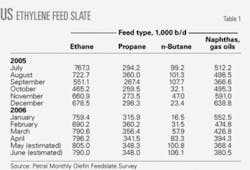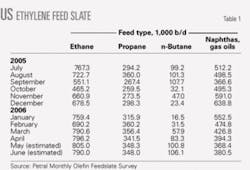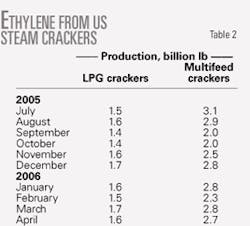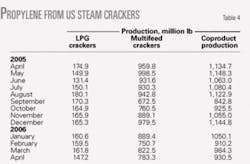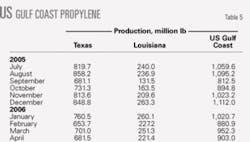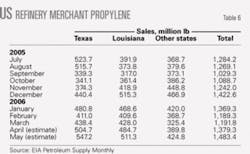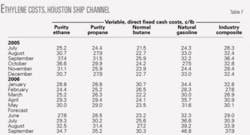North American olefins industry recovers from storm damage
Olefin markets in the US were supposed to return to normal in the second quarter of 2006. In some ways, however, second-quarter 2006 was as tempestuous as the third and fourth quarter 2005.
During first-quarter 2006, ethylene producers and refiners completed repairs to most of the facilities that suffered hurricane-related damage. In addition, the shift to ethanol from methyl tertiary butyl ether for reformulated gasoline production was one of the key developments in second-quarter 2006 that influenced pricing and economic relationships for US olefin markets.
The refining industry began to make the shift to ethanol from MTBE as the oxygenate blendstock for reformulated gasoline production in April 2006. Gasoline marketers experienced widespread problems with ethanol distribution during April and May.
During mid-March through mid-May, gasoline prices surged to levels that were similar to those during the first few weeks of September 2005 after Hurricane Rita. Octane values were also at record high levels during April and May 2006. The spike in motor gasoline prices and its impact on octane values and economic relationships proved to be almost as significant for olefins markets as the loss of production caused by Hurricanes Katrina and Rita.
Ethylene plants were supposed to operate at full capacity during the first and second quarter of 2006. The industry did not meet this objective even though repairs to the ethylene plants at Innovene LLC’s Chocolate Bayou, Tex., and Formosa Plastics Corp.’s Point Comfort, Tex., units were completed during first-quarter 2006.
On Apr. 1, 2006, the ethylene industry had full capacity available for production for the first time in 8 months. Huntsman Corp., however, experienced a major fire at its Port Arthur, Tex., plant in late April. According to official company statements, this plant was likely to be out of service for several months.
During first-quarter 2006, the refining industry also completed repairs to damage caused by hurricanes. According to data published by the US Energy Information Administration (EIA), refinery crude processing capacity in operation in PADD III totaled 8.3 million b/d in March vs. 7.1 million b/d in fourth-quarter 2005 and 8.0 million b/d in third-quarter 2006.
Olefin plant feed slates
Ethylene producers increased significantly their consumption of ethane and propane during first-quarter 2006. Total consumption of these two feedstocks averaged 1.09 million b/d in first-quarter 2006 or 212,000 b/d more than in fourth-quarter 2005. The ethylene industry’s consumption of ethane and propane in first-quarter 2006 was about the same as during the first and second-quarter 2005.
Ethane and propane accounted for 68% of the industry’s total consumption of fresh feed in first-quarter 2006. Based on the fraction of fresh feed, the rebound in ethane and propane consumption in first-quarter 2006 was stronger than the increase in volume indicated. Before then, ethane and propane never accounted for more than 65% of the industry’s fresh feed during 2003-05.
Table 1 shows recent trends in olefin plants’ feed slates.
Because the ethylene industry did not increase production rates to full capacity in first-quarter 2006 as was anticipated in January, total consumption of fresh feed averaged only 1.61 million b/d in first-quarter 2006 vs. 1.76 million b/d in first and second-quarter 2005.
In contrast to ethane-propane consumption, however, the industry’s use of naphthas and other heavy feeds declined in first-quarter 2006. Consumption of heavy feeds averaged 485,000 b/d in first-quarter 2006 vs. 575,000 b/d in fourth-quarter 2005 and 559,000 b/d in the first half of 2005.
Ethylene plants will run at 85-88% of available capacity during third and fourth-quarter 2006. Even though propylene prices are likely to remain strong during third-quarter 2006, incremental economics will remain favorable for ethane and feedstock demand for ethane will remain strong. Similarly, propane availability will be plentiful during third-quarter 2006 and feedstock demand for propane will also remain strong.
Figs. 1 and 2 show historic trends in ethylene feed slates.
null
Ethylene production
In first-quarter 2006, 55.9 billion lb of nameplate ethylene capacity was available to ethylene producers vs. the industry’s full nameplate capacity of 61.2 billion lb/year. In addition to 3.6 billion lb/year of capacity out of service and under repair, turnarounds in January and February reduced capacity another 1.75 billion lb/year.
Ethylene production from US olefin plants was 12.7 billion lb in first-quarter 2006. The industry’s operating rate averaged 86.5% on a full nameplate basis and 90.9% on an adjusted capacity basis.
Production in first-quarter 2006 was 0.88 billion lb more than in fourth-quarter 2005 but production was significantly lower than in first and second-quarter 2005 (13.9 billion lb and 13.7 billion lb, respectively). Ethylene production from LPG crackers increased 0.26 billion lb and production from multifeed crackers increased 0.62 billion lb in first-quarter 2006 (Table 2).
Based on nameplate capacity, LPG crackers accounted for 38% of total production in first-quarter 2006 and operated at 91.5% of nameplate capacity. Multifeed crackers accounted for 62% of production and operated at 86.5% of capacity in first-quarter 2006.
Table 3 shows ethylene production from plants in Texas and Louisiana.
US propylene production
Spot prices for chemical-grade propylene averaged 43¢/lb in first-quarter 2006 vs. 48¢/lb in fourth-quarter 2005. Propylene prices were also weaker in relation to unleaded regular and alkylate in first-quarter 2006.
The decline in propylene spot prices reduced coproduct credits during first-quarter 2006. The decline in coproduct credits contributed to the increase in variable production costs for light naphthas vs. ethane.
Coproduct propylene production from olefin plants therefore totaled 2.9 billion lb in first-quarter 2006 or 181 million lb less than in fourth-quarter 2005. The decline in coproduct production was consistent with the quarter-to-quarter decline in propylene prices. As ethylene producers increased their use of ethane during first-quarter 2006, coproduct propylene yields declined to 23.2% of ethylene production vs. 26.4% in fourth-quarter 2005.
Table 4 shows trends in coproduct propylene production from LPG and multifeed plants.
In first-quarter 2006, propylene production from olefin plants in Texas totaled 2.12 billion lb (Table 5) and the propylene-ethylene production ratio averaged 24.8% vs. 28.3% in fourth-quarter 2005. Propylene production in Louisiana was 0.74 billion lb in first-quarter 2006 and the propylene-ethylene production ratio averaged 21.2% vs. 24.1% in fourth-quarter 2005.
Fig. 3 shows trends in coproduct propylene production from olefin plants in Texas and Louisiana.
Refinery propylene supply
Merchant sales of refinery-grade propylene usually decline in the first quarter due to seasonal factors. Refineries generally conduct late winter maintenance work beginning in the first quarter and operate at lower rates.
In addition, refineries typically operate FCCs in distillate fuel oil mode. By-product propylene yields from FCC units are therefore usually somewhat lower in the first quarter. In first-quarter 2006, however, merchant sales of refinery grade propylene were 3.75 billion lb and were unchanged compared with sales in fourth-quarter 2005 (Table 6).
In third-quarter 2006, refinery merchant sales of propylene will be 1.40-1.45 billion lb/month and production will total 4.0-4.25 billion lb.
Fig. 4 shows trends in refinery merchant propylene sales.
Propylene inventories
On May 1, 2006, inventories of refinery-grade propylene were only 500 million lb, about 250 million lb lower than on Jan. 1, 2006. On May 1, 2006, refinery-grade propylene inventories were lower than at any time in 2005.
Because refinery-grade propylene availability in first-quarter 2006 was the same as in fourth-quarter 2005, the decline in inventory indicates that refinery propylene fractionators operated at full capacity. Furthermore, due to industry’s increased use of ethane, some ethylene plants had spare capacity in their propylene towers and were able to process more refinery-grade propylene in first-quarter 2006 than during fourth-quarter 2005.
Fig. 5 shows trends in refinery-grade propylene inventories.
Ethylene economics, prices
Feedstock prices, coproduct values, and ethylene plant yields determine ethylene production costs. We maintain direct contact with the olefin industry and track historic trends in spot prices for ethylene and propylene. We use a variety of sources to track trends in feedstock prices.
Some ethylene plants have the necessary process units to convert all coproducts into high-purity streams. Some ethylene plants, however, do not have the capability to upgrade mixed or crude streams of various coproducts; they sell some or all their coproducts at discounted prices. We evaluate ethylene production costs in this article based on all coproducts valued at spot prices.
Ethylene production costs
During first-quarter 2006, spot prices for all feedstocks declined. In contrast, spot prices for propylene increased in February and March and spot prices for benzene, toluene, and xylenes were steady during February and March. These price trends reduced the composite ethylene production cost to 27¢/lb in February and March from 33¢/lb in January.
During second-quarter 2006, however, spot prices for most feedstocks and coproducts increased. The rebound in feedstock prices outweighed the increases in coproduct prices; the Houston Ship Channel composite production cost rebounded to 30-32¢/lb in April and May.
The Houston Ship Channel composite production cost will average 29-31¢/lb during July. In August and September, however, a late summer rally in crude prices will push feedstock costs higher and the Houston Ship Channel composite production cost will jump to 37-39¢/lb. Forecasts for third-quarter 2006 do not include any hurricane-related disruption to crude production in the Gulf of Mexico.
Table 7 summarizes trends in ethylene production costs.
Ethylene prices, profit margins
During first-quarter 2006, spot prices for ethylene declined to 36.5¢/lb in March from 47.6¢/lb in January. Ethylene contract prices declined 6¢/lb during first-quarter 2006. The decline in ethylene prices reduced the industry’s profit margin to about 7¢/lb in March from 14-15¢/lb in January.
Spot ethylene prices stabilized in April but contract prices declined 3¢/lb. With the 5¢/lb increase in the composite production cost in April, the industry’s profit margin was a meager 2¢/lb.
In the aftermath of the fire at the Huntsman Chemical plant in Port Arthur, spot prices for ethylene jumped sharply during the first two weeks of May. By the end of May, however, spot prices for ethylene were again 44-45¢/lb and continued to weaken during June.
The industry’s profit margin averaged 8.1¢/lb in second-quarter 2006. In third-quarter 2006, forecasts for ethylene prices and production costs indicate that the industry’s profit margin will average 7-8¢/lb.
Figs. 6 and 7 show historic trends in ethylene prices and profit margins.
null
Propylene economics, prices
Spot prices for refinery-grade propylene prices fell to a low of 37.75¢/lb in January. As refineries went into their late winter maintenance turnarounds in February and March, spot prices for refinery-grade propylene rebounded and averaged 42.75¢/lb in February and 41.5¢/lb in March.
For first-quarter 2006, spot prices for refinery-grade propylene averaged 40.7¢/lb and contract prices averaged 39.2¢/lb.
During April 2006, spot prices for unleaded regular and alkylate jumped 30¢/gal. Spot and contract prices for refinery-grade propylene were unchanged in April.
In May, however, refinery-grade propylene buyers reacted to the loss of propylene supply from Huntsman’s plant at Port Arthur. Spot prices jumped to 46¢/lb during the first few days of May. Propylene buyers strongly resisted the initial spike in spot prices for refinery-grade propylene, however, and contract prices for May settled at 44.375¢/lb.
Spot prices were about 47-48¢/lb in late May and early June and contract prices for June settled at 47.5¢/lb.
Spot prices for chemical-grade propylene ran up to 44.5¢/lb in February from 41.75¢/lb in January but spot prices were slightly weaker in March and averaged 43¢/lb. For first-quarter 2006, spot prices for chemical-grade propylene averaged 43.1¢/lb and were 2.4¢/lb higher than spot prices for refinery-grade propylene.
In April, spot prices for chemical-grade propylene were again about 43-44¢/lb and averaged 43.5¢/lb. Prices jumped to 47.5¢/lb in May and 49-50¢/lb in June. The chemical-grade propylene premium vs. refinery-grade propylene averaged 2.6¢/lb in second-quarter 2006.
Contract prices for chemical-grade propylene averaged 43.9¢/lb in first-quarter 2006 and 48.5¢/lb in second-quarter 2006.
Spot prices for polymer-grade propylene increased 3.25¢/lb in February and averaged 46.5¢/lb. Spot prices declined 1.5¢/lb in March and averaged 45¢/lb. In first-quarter 2006, spot prices for chemical-grade propylene averaged 44.9¢/lb and were 1.8¢/lb higher than spot prices for chemical-grade propylene. Polymer-grade propylene prices were at a 4.25¢/lb premium vs. refinery-grade propylene in first-quarter 2006.
In April, spot prices for polymer-grade propylene were again in the range of 45-46¢/lb. Prices jumped to 49.5¢/lb in May and 50-51¢/lb in June. The polymer-grade propylene premium vs. refinery-grade propylene averaged 4.0¢/lb in second-quarter 2006. The premium for polymer-grade propylene vs. chemical-grade propylene averaged 1.8¢/lb in second-quarter 2006.
Octane values
We evaluate the relative strength of spot prices for refinery-grade propylene by comparing them to US Gulf Coast spot prices for alkylate, a gasoline octane blendstock that is widely traded among Gulf Coast refiners. Historically, the relationship between spot prices for refinery-grade propylene and alkylate is a leading indicator that signals swings in refinery merchant sales.
Fig. 8 shows trends in spot prices for refinery-grade propylene and alkylate.
During first-quarter 2006, differentials between refinery-grade propylene and alkylate spot prices were 5-12¢/lb. Spot prices for refinery-grade propylene averaged 7.8¢/lb more than alkylate for first-quarter 2006.
In April, however, propylene buyers resisted pressures from the strong rally in unleaded regular and alkylate spot prices. The refinery-grade propylene premium vs. alkylate was therefore only 0.3¢/lb in April.
Although unleaded regular spot prices declined about 8¢/gal in May, spot prices for alkylate remained strong. The jump in spot prices during May and June pushed the premium for refinery-grade propylene to 5.1¢/lb in May and 10-11¢/lb in June.
Outlook
Price forecasts for ethylene, propylene, and ethylene feedstocks are based on spot prices for West Texas Intermediate crude of $68-72/bbl during June and July. When crude and gasoline inventories decline during third-quarter 2006, however, bullish pressures on WTI prices will strengthen. In August and September, WTI prices will increase to $76-80/bbl.
In the gasoline markets, the shift from MTBE to ethanol for various regional markets for reformulated gasoline caused a spike in octane values. Based on wholesale market spot prices for unleaded regular and unleaded premium, incremental values of octane spiked to 4-5¢/octane-gal in May from 2-4¢/octane-gal in March and April.
Octane values will decline to 1.5¢/octane-gal in September from 2.5-3.5¢/gal in June. The outlook for continued strength in octane values during June and July is particularly important for the forecasts for refinery-grade propylene prices.
The rally in WTI prices will carry spot prices for all feedstocks higher during August and September and will boost composite production costs 5-7¢/lb.
On the supply-demand front, increases in ethylene production from other olefin plants were enough to offset production losses from Huntsman at Port Arthur in May. Trends in ethylene spot prices during May indicate that ethylene supplies will be plentiful during third and fourth-quarter 2006 barring any further loss of production capacity due to fires or extended disruptions due to hurricanes.
The hurricane season may bring several strong storms into the Gulf of Mexico during August and September. The fourth-quarter outlook will therefore change significantly if refineries and olefin plants suffer downtime and damage similar to the problems caused by Katrina and Rita in 2005.
Based on the supply-demand outlook for the third quarter, ethylene prices will average 40-42¢/lb in July. The expected surge in feedstock prices and production costs will push spot prices for ethylene to 44-45¢/lb in August and 45-47¢/lb in September.
In fourth-quarter 2006, spot prices for ethylene will drift lower and will average 43-44¢/lb. Profit margins for ethylene will average 8¢/lb in third-quarter 2006 and 6-7¢/lb in fourth-quarter 2006.
Spot prices for refinery-grade propylene will average 46-48¢/lb during third-quarter 2006 and 41-42¢/lb in fourth-quarter 2006. At this level, refinery-grade propylene price premiums vs. alkylate will average 8-9¢/lb in third-quarter 2006 and 7-8¢/lb in fourth-quarter 2006.
Spot prices for polymer-grade propylene will average 5¢/lb more than refinery-grade propylene during third and fourth-quarter 2006. Spot prices for chemical-grade propylene will average 1.5¢/lb less than polymer-grade propylene prices during third and fourth-quarter 2006.
The author
Dan Lippe is president of Petral Cos., Houston. In 1974, he began working for Diamond Shamrock Chemical Co. in a variety of technical and plant-management positions. He began his consulting career in 1979 and was employed by Resource Planning Consultants as a partner 1981-86. After RPC’s merger with Bonner & Moore, Lippe served as manager of NGL studies until 1988. He holds a BS in chemical engineering from Texas A&M University and an MBA from Houston Baptist University. He is a member of GPA and chaired its NGL Market Information Committee 1992-94 and 1996-2000 and is currently the committe vice-chair.
